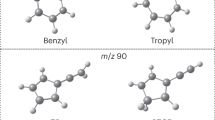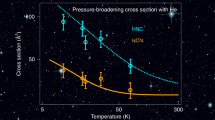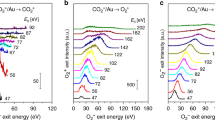Abstract
Termolecular association reactions involve ephemeral collision complexes—formed from the collision of two molecules—that collide with a third and chemically inert ‘bath gas’ molecule that simply transfers energy to/from the complex. These collision complexes are generally not thought to react chemically on collision with a third molecule in the gas-phase systems of combustion and planetary atmospheres. Such ‘chemically termolecular’ reactions, in which all three molecules are involved in bond making and/or breaking, were hypothesized long ago in studies establishing radical chain branching mechanisms, but were later concluded to be unimportant. Here, with data from ab initio master equation and kinetic-transport simulations, we reveal that reactions of H + O2 collision complexes with other radicals constitute major kinetic pathways under common combustion situations. These reactions are also found to influence flame propagation speeds, a common measure of global reactivity. Analogous chemically termolecular reactions mediated by ephemeral collision complexes are probably of significance in various combustion and planetary environments.
This is a preview of subscription content, access via your institution
Access options
Access Nature and 54 other Nature Portfolio journals
Get Nature+, our best-value online-access subscription
$29.99 / 30 days
cancel any time
Subscribe to this journal
Receive 12 print issues and online access
$259.00 per year
only $21.58 per issue
Buy this article
- Purchase on Springer Link
- Instant access to full article PDF
Prices may be subject to local taxes which are calculated during checkout



Similar content being viewed by others
References
Lindemann, F. A. et al. Discussion on ‘the radiation theory of chemical action’. Trans. Faraday Soc. 17, 598–606 (1922).
Hinshelwood, C. N. On the theory of unimolecular reactions. Proc. R. Soc. Lond. A 113, 230–233 (1926).
Widom, B. Molecular transitions and chemical reaction rates. Science 148, 1555–1560 (1965).
Jasper, A. W. et al. Predictive a priori pressure-dependent kinetics. Science 346, 1212–1215 (2014).
Perrin, J. Radiation and chemistry. Trans. Faraday Soc. 17, 546–572 (1922).
Vuitton, V., Yelle, R. V., Lavvas, P. & Klippenstein, S. J. Rapid association reactions at low pressure: impact on the formation of hydrocarbons on titan. Astrophys. J. 744, 1–7 (2012).
Zare, R. N. Laser control of chemical reactions. Science 279, 1875–1879 (1998).
Yan, S., Wu, Y. T., Zhang, B. L., Yue, X. F. & Liu, K. P. Do vibrational excitations of CHD3 preferentially promote reactivity toward the chlorine atom? Science 316, 1723–1726 (2007).
Olzmann, M., Gebhardt, J. & Scherzer, K. An extended mechanism for chemical activation systems. Int. J. Chem. Kinet. 23, 825–835 (1991).
Glowacki, D. R. et al. Interception of excited vibrational quantum states by O2 in atmospheric association reactions. Science 337, 1066–1069 (2012).
Burke, M. P., Goldsmith, C. F., Georgievskii, Y. & Klippenstein, S. J. Towards a quantitative understanding of the role of non-Boltzmann reactant distributions in low-temperature oxidation. Proc. Combust. Inst. 35, 205–213 (2015).
Dong, W. et al. Transition-state spectroscopy of partial wave resonances in the F + HD reaction. Science 327, 1501–1502 (2010).
Kim, J. B. et al. Spectroscopic observation of resonances in the F + H2 reaction. Science 349, 510–513 (2015).
Hinshelwood, C. N. & Green, T. E. The interaction of nitric oxide and hydrogen and the molecular statistics of termolecular gaseous reactions. J. Chem. Soc. 129, 730–739 (1926).
Hinshelwood, C. N. & Williamson, A. T. The Reaction between Hydrogen and Oxygen (Oxford Univ. Press, 1934).
Semenov, N. N. Chemical Kinetics and Chain Reactions (Oxford Univ. Press, 1935).
Baldwin, R. R. The first limit of the hydrogen + oxygen reaction in potassium chloride-coated vessels. Trans. Faraday Soc. 52, 1344–1354 (1956).
Burke, M. P., Chaos, M., Ju, Y., Dryer, F. L. & Klippenstein, S. J. Comprehensive H2/O2 kinetic model for high-pressure combustion. Int. J. Chem. Kinet. 44, 444–474 (2012).
Kéromnès, A. et al. An experimental and detailed chemical kinetic modeling study of hydrogen and syngas mixture oxidation at elevated pressures. Combust. Flame 160, 995–1011 (2013).
Dixon-Lewis, G. Flame structure and flame reaction kinetics. I. Solution of conservation equations and application to rich hydrogen-oxygen flames. Proc. R. Soc. Lond. A 298, 495–513 (1967).
Dixon-Lewis, G. & Williams, D. J. in Comprehensive Chemical Kinetics Vol. 17 (eds Branford, C. H. & Tippler, C. F. H.) 1–248 (Elsevier, 1977).
Wu, T., Werner, H. J. & Manthe, U. First-principles theory for the H + CH4 → H2 + CH3 reaction. Science 306, 2227–2229 (2004).
Czakó, G. & Bowman, J. M. Dynamics of the reaction of methane with chlorine atom on an accurate potential energy surface. Science 334, 343–346 (2011).
Tse, S. D., Zhu, D. L. & Law, C. K. Morphology and burning rates of expanding spherical flames in H2/O2/inert mixtures up to 60 atmospheres. Proc. Combust. Inst. 28, 1793–1800 (2000).
Yelle, R. V. et al. Formation of NH3 and CH2NH in Titan's upper atmosphere. Faraday Discuss. 147, 31–49 (2010).
Bar-Nun, A., Bar-Nun, N., Bauer, S. H. & Sagan, C. Shock synthesis of amino acids in simulated primitive environments. Science 168, 470–472 (1970).
Rimmer, P. B. & Helling, Ch. A chemical kinetics network for lightning and life in planetary atmospheres. Astrophys. J. Supp. Ser. 224, 1–33 (2016).
Bunker, D. L. & Davidson, N. On the interpretation of halogen atom recombination rates. J. Am. Chem. Soc. 80, 5090–5096 (1958).
Liu, J. & Barker, J. R. On the chaperon mechanism: application to ClO + ClO (+N2) → ClOOCl (+N2). J. Phys. Chem. A 111, 8689–8698 (2007).
Sleiman, C. et al. Pressure dependent low temperature kinetics for CN + CH3CN: competition between chemical reaction and van der Waals complex formation. Phys. Chem. Chem. Phys. 18, 15118–15132 (2016).
Miller, J. A. & Klippenstein, S. J. Master equation methods in gas phase chemical kinetics. J. Phys. Chem. A 110, 10528–10544 (2006). .
Pilling, M. J. & Robertson, S. H. Master equation models for chemical reactions of importance in combustion. Ann. Rev. Phys. Chem. 54, 245–275 (2003).
Barker, J. R. & Golden, D. M. Master equation analysis of pressure-dependent atmospheric reactions. Chem. Rev. 103, 4577–4591 (2003).
Georgievskii, Y., Miller, J. A., Burke, M. P. & Klippenstein, S. J. Reformulation and solution of the master equation for multiple-well chemical reactions. J. Phys. Chem. A 117, 12146–12154 (2013).
Sellevåg, S. R., Georgievskii, Y. & Miller, J. A. The temperature and pressure dependence of the reactions H + O2 (+M) → HO2 (+M) and H + OH (+M) → H2O (+M). J. Phys. Chem. A 112, 5085–5095 (2008).
Maranzana, A., Barker, J. R. & Tonachini, G. Master equation simulations of competing unimolecular and bimolecular reactions: application to OH production in the reaction of acetyl radical with O2 . Phys. Chem. Chem. Phys. 9, 4129–4141 (2007).
Fernández-Ramos, A. & Varandas, A. J. C. A VTST study of the H + O3 and O + HO2 reactions using a six-dimensional DMBE potential energy surface for ground state HO3 . J. Phys. Chem. A 106, 4077–4083 (2002).
Burke, M. P., Klippenstein, S. J. & Harding, L. B. A quantitative explanation for the apparent anomalous temperature dependence of OH + HO2 = H2O + O2 through multi-scale modeling. Proc. Combust. Inst. 34, 547–555 (2013).
Kee, R. J., Dixon-Lewis, G., Warnatz, J., Coltrin, M. E. & Miller, J. A. A Fortran Computer Code Package for the Evaluation of Gas-Phase, Multi-Component Transport Properties. Technical Report SAND86-8246 (Sandia National Laboratories, 1986).
Georgievskii, Y. & Klippenstein, S. J. MESS.2016.3.23 (2013); http://tcg.cse.anl.gov/papr/codes/mess.html
CHEMKIN (Reaction Design); http://www.reactiondesign.com/products/chemkin/
Goodwin, D. G., Moffat, H. K. & Speth, R. L. Cantera V.2.3.0 (2017); http://www.cantera.org
Acknowledgements
This material is based on work supported by the US Department of Energy, Office of Science, Office of Basic Energy Sciences, Division of Chemical Sciences, Geosciences, and Biosciences under contract no. DE-AC02-06CH11357. M.P.B. acknowledges financial support from Columbia University.
Author information
Authors and Affiliations
Contributions
M.P.B. and S.J.K. conceived and designed the calculations. M.P.B. performed the master equation calculations with technical input from S.J.K., and M.P.B. performed the kinetic-transport calculations. Both authors contributed to writing the paper.
Corresponding author
Ethics declarations
Competing interests
The authors declare no competing financial interests.
Supplementary information
Supplementary information
Supplementary information (PDF 326 kb)
Rights and permissions
About this article
Cite this article
Burke, M., Klippenstein, S. Ephemeral collision complexes mediate chemically termolecular transformations that affect system chemistry. Nature Chem 9, 1078–1082 (2017). https://doi.org/10.1038/nchem.2842
Received:
Accepted:
Published:
Issue Date:
DOI: https://doi.org/10.1038/nchem.2842
This article is cited by
-
Three is the magic number
Nature Chemistry (2017)



